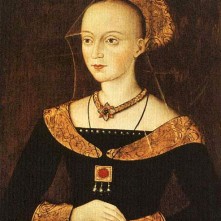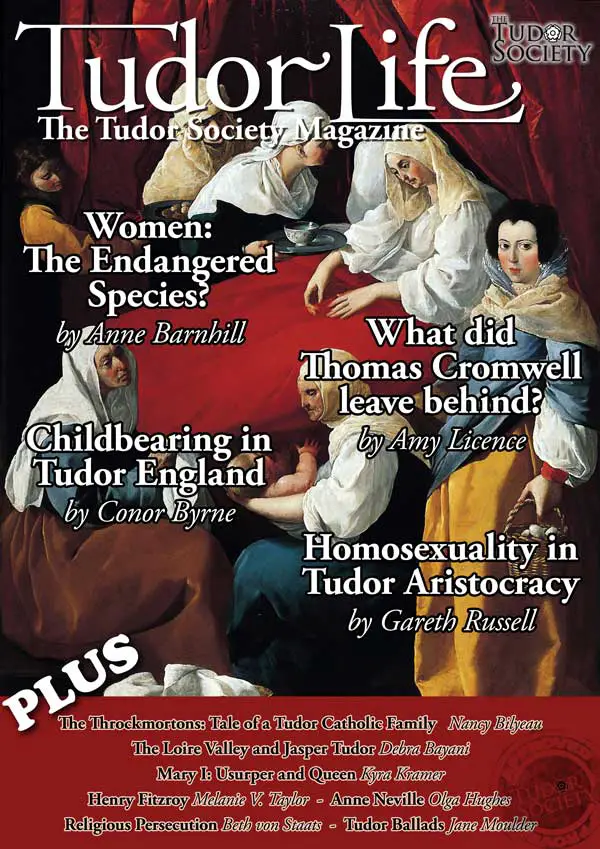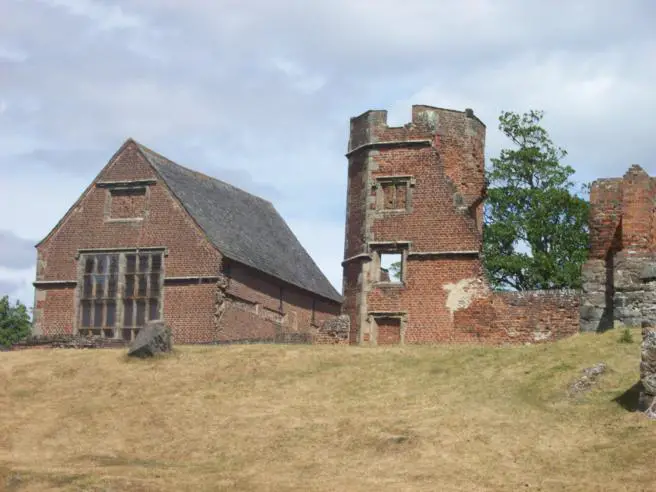8 June
1476 – Death of George Neville, administrator and Archbishop of York, at Blyth in Nottinghamshire. He was buried in York Minster.
1492 – Death of Elizabeth Woodville at Bermondsey Abbey. Elizabeth was the consort of Edward IV and mother of the Princes in the Tower. She was buried beside her husband in St George's Chapel, Windsor Castle. You can read more about Elizabeth Woodville in June 2015's Tudor Life magazine - click here.
1533 – Papal authority in England was denied by Parliament.
1536 – Parliament passed the second “Act of Succession” removing Henry VIII's daughters, Mary and Elizabeth, from the line of succession.
1536 – Henry Fitzroy, Duke of Richmond, made his last public appearance (at Parliament) before his death.
1590 – Death of Thomas Randolph, Elizabethan diplomat, at his home in St Peter's Hill, London. He was buried at St Peter Paul's Wharf. Randolph acted as a go-between for Elizabeth I and Mary, Queen of Scots, and also served his Queen in Russia and France. He has been described as the first English "career diplomat".
9 June
1511 – Death of William Courtenay, 1st Earl of Devon, at Greenwich. He died of pleurisy and was buried at Blackfriars, London, with the honours due an earl, even though he hadn't been officially invested yet. Courtenay was Henry VIII's uncle, having married Katherine, daughter of Edward IV and Elizabeth Woodville.1563 – (or 10th June) Death of William Paget, 1st Baron Paget, diplomat and administrator, probably at his estate of West Drayton in Middlesex. Paget's career included serving as an ambassador to the French court, being a member of Henry VIII's Privy Council, sitting on the commission which tried the Earl of Surrey and serving on Mary I's Privy Council.
1573 – Death of William Maitland of Lethington, Scottish courtier, politician, reformer and diplomat. He died in prison in Leith, in suspicious circumstances, though it was said to be suicide. Maitland supported the restoration of Mary, Queen of Scots, and was imprisoned as a result.
1583 – Death of Thomas Radcliffe, 3rd Earl of Sussex, Lord Lieutenant of Ireland and President of the Council of the North, at Bermondsey. His body was buried at Boreham in Essex, but his innards were buried at the church in Bermondsey.
10 June
1464 – Birth of John Islip, Abbot of Westminster, probably at Islip, Oxfordshire. Islip became Abbot of Westminster in 1500, and was the last to hold this office by free choice of the community.1528 – Birth of Thomas Percy, 7th Earl of Northumberland. Percy was a staunch Catholic, and was involved in the failed Rising of the North in Elizabeth I's reign. He fled to Scotland, but was captured and taken to York on 22nd August 1572, where he was beheaded in the Pavement, and his head put on display on Micklegate Bar. His body was buried in St Crux Church.
1537 – Deaths of Blessed Thomas Green and Blessed Walter Pierson, Carthusian monks from London Charterhouse, in Newgate Prison, from starvation. They were two out of nine monks who were purposely starved to death for refusing to accept the royal supremacy. Others were hanged, drawn and quartered.
1540 - Arrest of Thomas Cromwell, 1st Earl of Essex, in the council chamber at Westminster. Click here to read more about it.
1584 – Death of Francis, Duke of Anjou and Alençon, a suitor whom Elizabeth I dubbed "Frog", in Paris. It is thought that he died of malaria.
1607 – Death of Sir John Popham, lawyer, Judge and Speaker of the House of Commons. He was buried in Wellington, Somerset.
1612 – Funeral of Robert Cecil, 1st Earl of Salisbury, at Hatfield.
11 June
1456 – Birth of Anne Neville, Queen Consort of Richard III, at Warwick Castle. Anne was the daughter of Richard Neville, 16th Earl of Warwick and 6th Earl of Salisbury, known as the Kingmaker, and his wife, Anne Beauchamp.1488 – Death of James III of Scotland, at Sauchieburn, or “the field of Stirling”. It is not known whether he died in battle or after the battle.
1509 – Marriage of Henry VIII and Catherine of Aragon at Greenwich Palace - click here to read more about it.
1540 – Birth of Barnabe Googe, translator and poet. Googe is known as one of the earliest English pastoral poets.
1544 – Bishops ordered by Henry VIII to ensure that the new litany was “in our native englysshe tonge”.
1560 – Death of Marie de Guise (Mary of Guise), former consort of James V and regent of Scotland, at Edinburgh Castle. Her body lay in a lead coffin at the castle, in St Margaret's Chapel, until March 1561 when it was taken back to France. Marie was buried in the convent of St Pierre at Rheims.
1576 – Death of Sir Anthony Cooke, humanist and educator. Cooke educated his daughters to a high standard, teaching them Latin and Greek, and probably also modern languages and Hebrew. He was appointed royal tutor to Edward VI, but it is not known whether he actually tutored the King. It may have been more of a guiding role. He was buried at Romford, and his effigy can be seen at St Edward's Church there.
12 June
1492 – Burial of Elizabeth Woodville, former consort of Edward IV, next to her husband in St George's Chapel, Windsor Castle.1511 – Burial of William Courtenay, 1st Earl of Devon, at Blackfriars.
1530 – Catherine of Aragon told Henry VIII to abandon his “wicked” life.
1535 – Richard Rich interviewed Sir Thomas More in the Tower of London. He later reported, at More's trial, that More had denied the royal supremacy during this interview.
1540 - The newly imprisoned Thomas Cromwell wrote to King Henry VIII from the Tower of London, asking for mercy and pleading his innocence.
1553 – Edward VI's council commanded the judges of the King's Bench to turn Edward's "Devise for the succession" into a legal will.
1567 – Death of Richard Rich, 1st Baron Rich and Lord Chancellor, at Rochford. He was buried at Felstead. Richard Rich was Lord Chancellor in Edward VI's reign and went on to serve in Mary I's Privy Council.
1573 – Birth of Robert Radcliffe, 5th Earl of Sussex, courtier and soldier. He was the son of Henry Radcliffe, 4th Earl of Sussex, and his wife, Honor. Radcliffe served Elizabeth I as an ambassador and as Earl Marshal and Colonel General of her army. He was appointed Lord Lieutenant of Essex by James I in 1603.
13 June
1535 – Death of George Neville, 3rd Baron Bergavenny, on 13th or 14th June at his home in Sussex. He was buried at Birling. Neville was a member of Henry VII's council and a Garter knight, but his career was adversely affected when his father-in-law, Edward Stafford, 3rd Duke of Buckingham, fell in 1521. Neville was imprisoned for a year in the Tower of London, and although he was pardoned, he lost his offices and was forced to sell his home, Birling, to the King. He bought back his home in 1530, when he had once again risen in favour.
1574 – Baptism of Richard Barnfield, poet, at the parish church of Norbury, Shropshire. Barnfield published various works in the 1590s, including “The Affectionate Shepheard: Containing ‘The Complaint of Daphnis for the Love of Ganymede’”.
1587 – Death of actor William Knell in a pub brawl in Thame. A coroner's inquest ruled that actor John Towne had drawn his sword and stuck it through Knell's neck in self-defence.
1592 – Death of Henry Scrope, 9th Baron Scrope of Bolton, soldier and warden of the west marches, in Carlisle. He was buried in Carlisle Cathedral.
1595 – Burial of William Wickham, Bishop of Winchester, in Southwark Cathedral.
1596 – Death of Hugh Bellot, Bishop of Bangor and Chester, at Tŷ Bellot, Denbighshire. His funeral was at Chester Cathedral, but he was buried in the parish church at Wrexham.
14 June
1557 – William Peto was made cardinal and papal legate, replacing Reginald Pole, Archbishop of Canterbury, as legate. During Henry VIII's Great Matter, Peto had been Catherine of Aragon's Confessor and had preached in support of her, comparing the King to Ahab.
1571 – Death of Sir Christopher Danby, a Yorkshire nobleman and Catholic. During the Pilgrimage of Grace, he was with the rebels at Pontefract Castle, but escaped punishment. However, his Catholic beliefs did cause him problems in Elizabeth I's reign, and he was brought before the Council of the North for questioning. Again, he escaped being charged.
1572 – Death of Thomas Warton, 2nd Baron Warton, soldier, Justice of the Peace, member of Parliament and a member of Mary I's Privy Council. He died at home, in Cannon Row, Westminster, and was buried in Westminster Abbey.
1598 – Death of Sir Henry Knyvet, MP and soldier, at Charlton in Wiltshire. He was buried in the church at Charlton in July 1598. Knyvet was a Gentleman Pensioner to Elizabeth I, a Justice of the Peace, Sheriff, Deputy Lieutenant, member of Parliament and soldier. He also wrote “Defence of the Realm.”
1612 – Death of Giles Tomson, Bishop of Gloucester, at Windsor Castle. He was buried in Bray Chapel at St George's Chapel, Windsor Castle. He had only been Bishop a year and hadn't even visited his diocese.








Leave a Reply